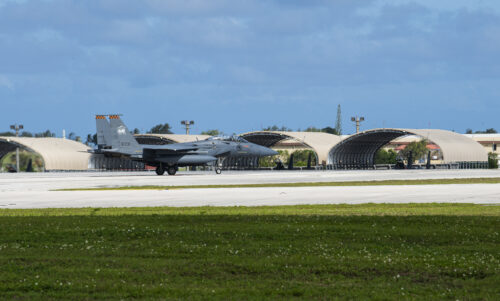In a move strengthening ties between the United States and Singapore, the U.S. Air Force has unveiled plans to beddown up to 12 Republic of Singapore Air Force (RSAF) F-15 fighter jets at Andersen Air Force Base (AFB), Guam. The decision is part of a revised proposal for the base’s infrastructure upgrades, aligning with strategic initiatives in the Indo-Pacific region.

The proposal, first announced on April 20, 2021, faced a temporary halt after an initial scoping period to reassess its scope. During the strategic pause, officials considered evolving strategic initiatives in the Indo-Pacific, leading to a revised proposal that now includes the RSAF F-15 beddown and associated mission support.
Andersen AFB, strategically positioned west of the International Date Line, will see critical infrastructure enhancements to support U.S. and partner nation forces within the Indo-Pacific. The proposal aims to provide the necessary facilities to beddown and operate RSAF fighter aircraft, addressing crucial training requirements.
The beddown plan includes the construction of new infrastructure adjacent to the northwest corner of the airfield and within the munitions storage area at Andersen AFB. This construction, anticipated to occur over three to seven years, encompasses airfield pavements, an aircraft hangar, maintenance and utility buildings, fuel systems, fencing and utilities, roadways and parking, stormwater management infrastructure, and earth-covered magazines.
Approximately 209 acres are expected to be disturbed during construction, either as developed sites or maintained vegetation post-construction. The proposed infrastructure, designed with flexibility in mind, could support not only the RSAF F-15 beddown but also other U.S. Department of the Air Force (DAF), service component, and partner nation aircraft or missions operating from Andersen AFB both now and in the future.
The proposal, first announced on April 20, 2021, faced a temporary halt after an initial scoping period to reassess its scope. During the strategic pause, officials considered evolving strategic initiatives in the Indo-Pacific, leading to a revised proposal that now includes the RSAF F-15 beddown and associated mission support.
Andersen AFB, strategically positioned west of the International Date Line, will see critical infrastructure enhancements to support U.S. and partner nation forces within the Indo-Pacific. The proposal aims to provide the necessary facilities to beddown and operate RSAF fighter aircraft, addressing crucial training requirements.
The beddown plan includes the construction of new infrastructure adjacent to the northwest corner of the airfield and within the munitions storage area at Andersen AFB. This construction, anticipated to occur over three to seven years, encompasses airfield pavements, an aircraft hangar, maintenance and utility buildings, fuel systems, fencing and utilities, roadways and parking, stormwater management infrastructure, and earth-covered magazines.
Approximately 209 acres are expected to be disturbed during construction, either as developed sites or maintained vegetation post-construction. The proposed infrastructure, designed with flexibility in mind, could support not only the RSAF F-15 beddown but also other U.S. Department of the Air Force (DAF), service component, and partner nation aircraft or missions operating from Andersen AFB both now and in the future.
The decision to beddown RSAF F-15s at Andersen AFB stems from a 2019 agreement between the U.S. and Singapore to establish a permanent training detachment at the base. This agreement marked a significant step in deepening defense ties between the two countries. The U.S. and Singapore signed the agreement in May 2021 to enhance the Air Force’s capability to support forces within the Indo-Pacific region and strengthen the U.S.’s ability to respond regionally and worldwide.
As part of the environmental considerations, the U.S. Air Force is undergoing an Environmental Impact Statement (EIS) process. The Draft EIS is anticipated in mid-2024, with the Final EIS and a decision on the Proposed Action expected in early to mid-2025.
The public has been invited to provide comments on the revised proposal during the 30-day scoping period, commencing with the publication of the Notice of Intent on the Federal Register website on December 15, 2023.
For more information, hit the Source below